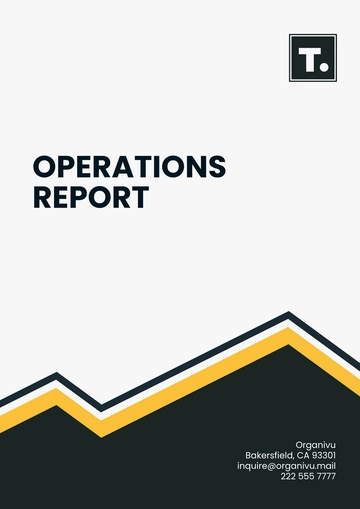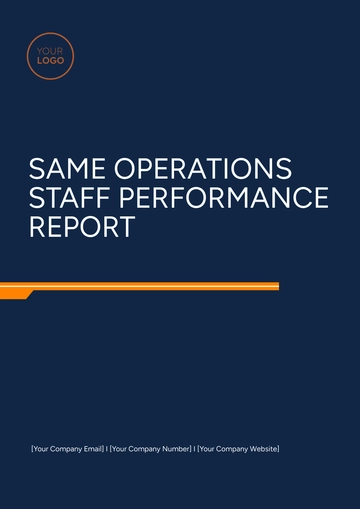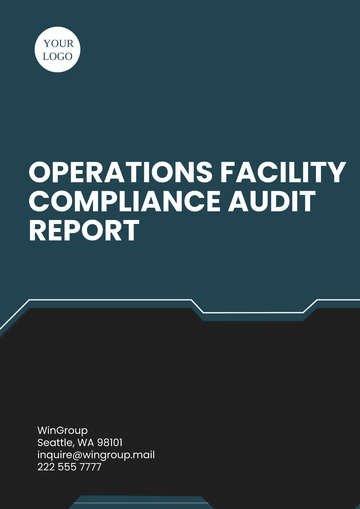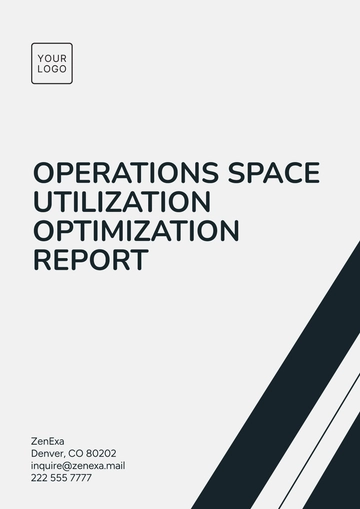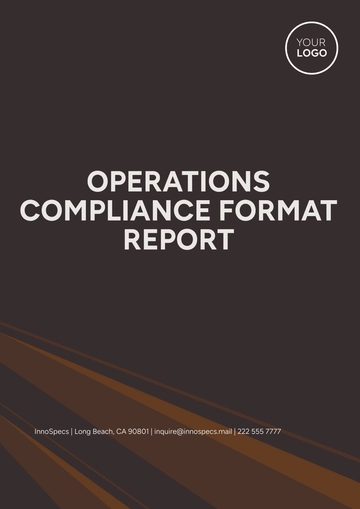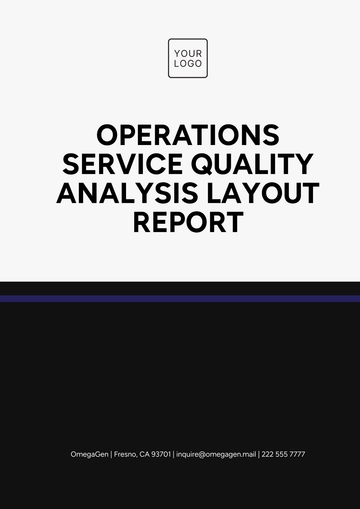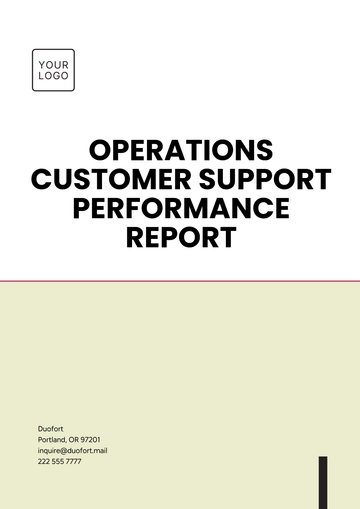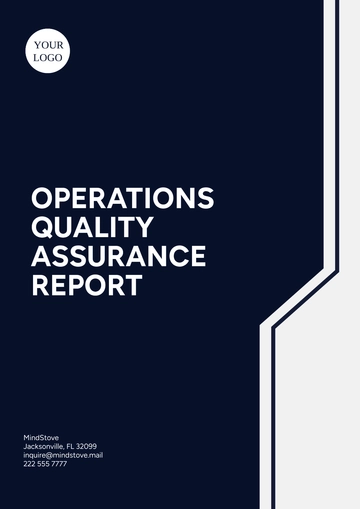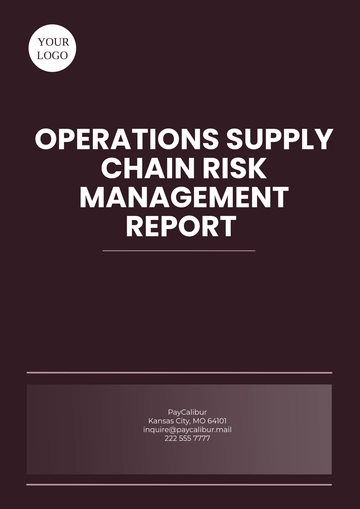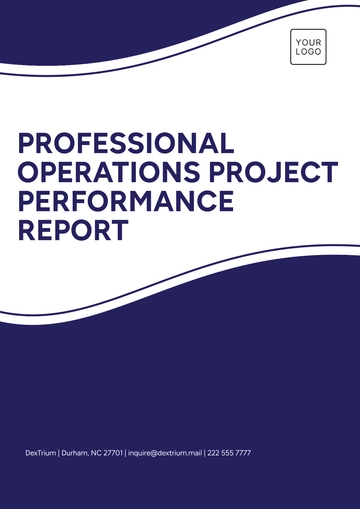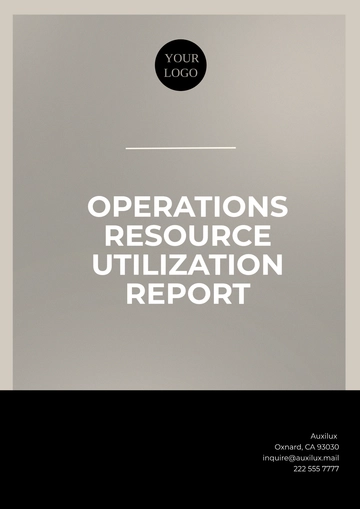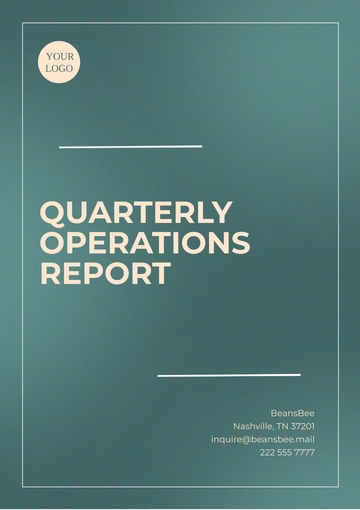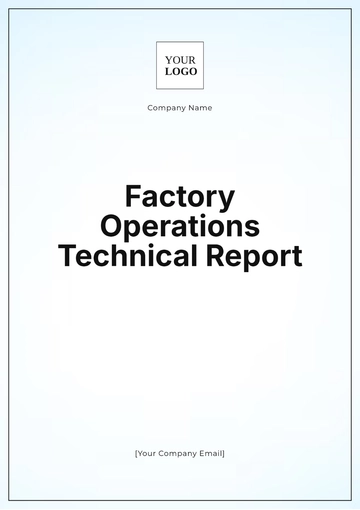Free Operations Supply Chain Report
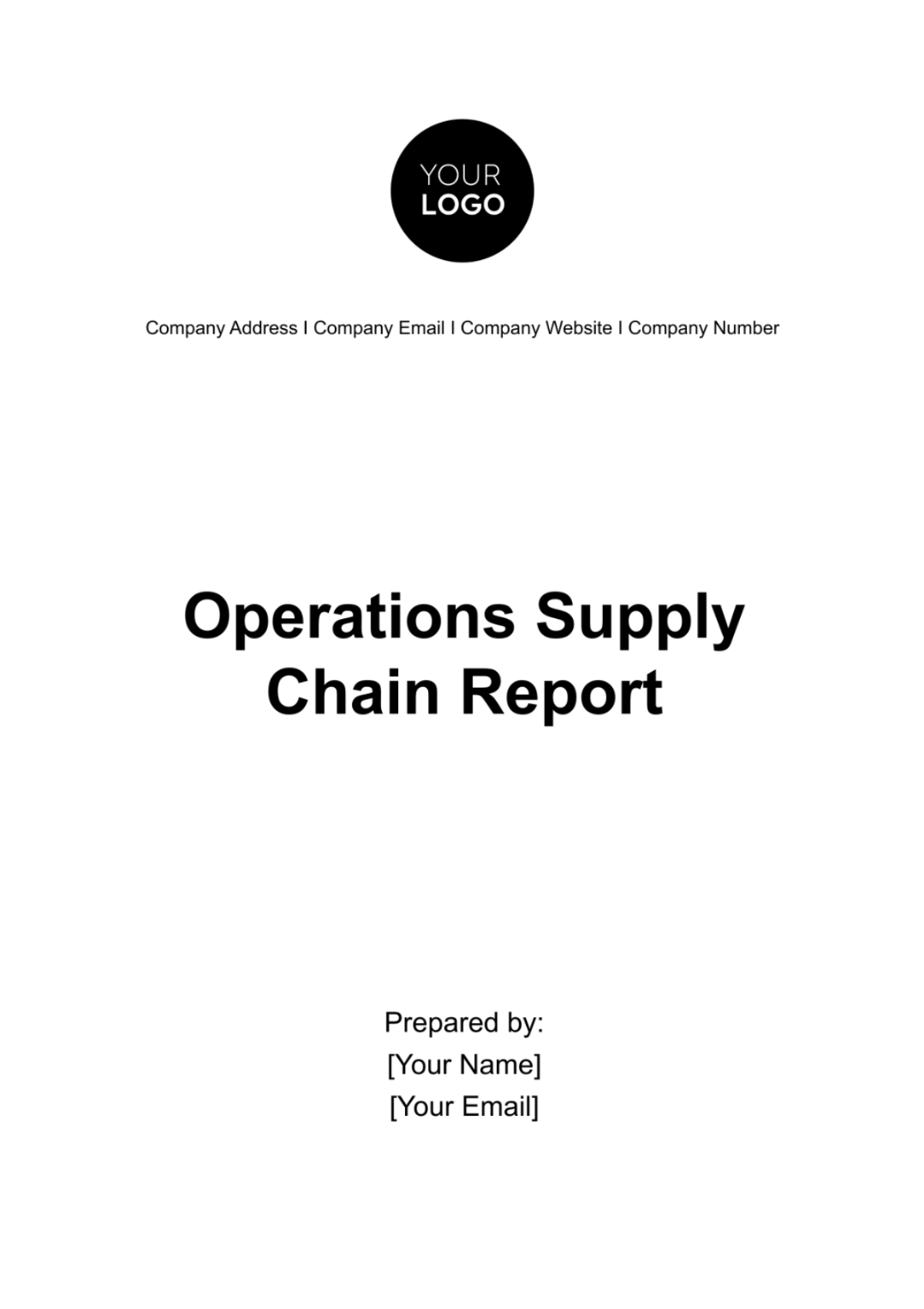
I. Executive Summary
The Operations Supply Chain Report provides a comprehensive analysis of [Your Company Name]'s current supply chain operations, focusing on identifying areas for improvement and optimization. Through a thorough examination of key performance metrics, challenges, and opportunities, this report aims to provide actionable insights to enhance efficiency, reduce costs, and improve overall performance within the supply chain.
A. Key Findings:
The current order fulfillment rate stands at [75%], below the industry benchmark of [85%], indicating potential issues with order processing and fulfillment efficiency.
On-time delivery performance is at [80%], falling short of the target rate of [90%], highlighting challenges in transportation and logistics management.
Inventory turnover is [6 times per year], which is above the industry average of [5 times per year], suggesting effective inventory management practices.
Warehouse utilization rate is [70%], below the optimal utilization rate of [80%], indicating opportunities to improve warehouse efficiency and capacity utilization.
B. Recommendations:
Implement automated order processing systems to streamline order fulfillment processes and improve efficiency.
Enhance transportation and logistics management through route optimization and real-time tracking technologies to ensure on-time deliveries.
Fine-tune inventory management strategies to balance inventory levels effectively and reduce carrying costs.
Invest in warehouse optimization initiatives, such as layout redesign and inventory management systems, to improve space utilization and operational efficiency.
II. Introduction
The operations supply chain is the backbone of [Your Company Name]'s business operations, encompassing the end-to-end process of sourcing, manufacturing, and delivering products to customers. As consumer expectations continue to evolve and market dynamics shift, optimizing the supply chain is essential to maintaining a competitive edge and meeting customer demands.
A. Scope of the Report:
This report focuses on analyzing the various facets of [Your Company Name]'s supply chain operations, including inventory management, logistics, distribution, and key performance indicators (KPIs). By examining current practices, identifying challenges, and exploring opportunities for improvement, we aim to provide strategic recommendations to enhance operational efficiency and drive business growth.
Table 1: Key Supply Chain Metrics
Metric | Current Performance | Target Performance |
|---|---|---|
Order Fulfillment Rate | [75%] | [85%] |
On-time Delivery Rate | [80%] | [90%] |
Inventory Turnover | [6] times per year | [5] times per year |
Warehouse Utilization Rate | [70%] | [80%] |
III. Methodology
The methodology employed in conducting the Operations Supply Chain Report involved a comprehensive approach to data collection, analysis, and interpretation. The following steps outline the methodology utilized:
A. Data Collection:
Utilized internal databases, ERP systems, and historical records to gather relevant data on supply chain operations, including inventory levels, order processing times, transportation costs, and warehouse utilization.
Conducted interviews with key stakeholders, including supply chain managers, logistics coordinators, and warehouse supervisors, to gain insights into current practices and challenges.
B. Data Analysis:
Employed statistical analysis techniques to evaluate key performance metrics, such as order fulfillment rates, on-time delivery performance, and inventory turnover.
Utilized trend analysis to identify patterns and fluctuations in supply chain performance over time, allowing for the identification of areas requiring improvement.
C. Comparative Analysis:
Benchmarked [Your Company Name]'s supply chain performance against industry standards and best practices to assess relative performance and identify areas of competitive advantage or improvement.
Compared internal performance metrics across different departments and regions to identify variations and opportunities for standardization and optimization.
D. Limitations:
Limited availability of historical data for certain metrics may have impacted the depth of analysis in some areas.
The reliance on self-reported data from stakeholders may introduce biases or inaccuracies in the analysis.
External factors such as market volatility and geopolitical events may have influenced supply chain performance but were not explicitly accounted for in the analysis.
IV. Current State Analysis
A. Supply Chain Overview
The supply chain overview provides a comprehensive assessment of [Your Company Name]'s current supply chain landscape, including key stakeholders, processes, and challenges.
Key Components:
Identification of key suppliers, distributors, and logistics partners involved in the supply chain network.
Mapping of supply chain processes from procurement to delivery, highlighting critical touchpoints and potential bottlenecks.
Assessment of challenges such as supply chain disruptions, inventory inaccuracies, and lead time variability.
Evaluation of sustainability practices and initiatives throughout the supply chain, including supplier diversity and environmental impact reduction efforts.
B. Inventory Management
The inventory management analysis focuses on evaluating [Your Company Name]'s current inventory practices and their impact on supply chain performance.
Key Metrics:
Inventory turnover rate: Measures the frequency at which inventory is sold and replaced within a specific period, indicating the efficiency of inventory management.
Inventory accuracy: Assesses the reliability of inventory data and the extent to which it reflects actual stock levels, with higher accuracy leading to improved decision-making and customer satisfaction.
Carrying costs: Examines the costs associated with holding inventory, including storage, insurance, and obsolescence, with the goal of minimizing carrying costs while ensuring adequate stock availability.
C. Logistics and Distribution
The logistics and distribution analysis examines [Your Company Name]'s transportation and distribution processes to identify opportunities for optimization and cost savings.
Key Areas of Focus:
Transportation modes: Assessment of the mix of transportation modes utilized (e.g., trucking, rail, air) and their respective costs and efficiencies, with the aim of optimizing the transportation network for cost-effectiveness and reliability.
Route optimization: Evaluation of route planning and scheduling practices to minimize transportation costs and delivery times, leveraging technology solutions such as route optimization software and real-time tracking systems.
Distribution network: Analysis of warehouse locations, capacity, and layout to ensure optimal distribution efficiency, considering factors such as proximity to suppliers and customers, warehouse automation technologies, and demand forecasting accuracy.
Table 2: Summary of Supply Chain Challenges
Challenge | Impact | Recommendations |
|---|---|---|
Supply chain disruptions | Increased lead times and costs | Develop contingency plans and alternative sourcing strategies |
Inventory inaccuracies | Reduced customer satisfaction | Implement cycle counting and RFID technologies for improved accuracy |
Transportation bottlenecks | Delays in delivery schedules | Invest in route optimization software and alternative transportation modes |
V. Performance Metrics
A. Key Performance Indicators (KPIs)
Key performance indicators (KPIs) are crucial metrics that reflect the performance of [Your Company Name]'s supply chain operations. By analyzing these KPIs, we can gain insights into areas of strength and areas that require improvement.
Key Metrics:
Order Fulfillment Rate: The percentage of customer orders successfully fulfilled within the specified time frame. A high order fulfillment rate indicates efficient order processing and inventory management, while a low rate may indicate inefficiencies in the fulfillment process.
On-time Delivery Rate: The percentage of customer orders delivered on or before the promised delivery date. A high on-time delivery rate is essential for maintaining customer satisfaction and loyalty. Delays in delivery can lead to dissatisfaction and potential loss of customers.
Inventory Turnover: The number of times inventory is sold and replaced within a specific period, usually a year. A high inventory turnover rate signifies efficient inventory management and optimal stock levels, while a low rate may indicate excess inventory or slow-moving products.
Warehouse Utilization Rate: The percentage of available warehouse space that is utilized for storing inventory. Maximizing warehouse utilization helps minimize storage costs and improve operational efficiency. Low warehouse utilization may indicate inefficient use of space or excess inventory.
B. Trend Analysis
Trend analysis involves examining historical data to identify patterns, trends, and variations in supply chain performance metrics over time. By analyzing trends, we can identify areas of improvement and make informed decisions to drive continuous improvement within the supply chain.
Key Observations:
Order Fulfillment Trend: Analyzing the trend in order fulfillment rates over the past quarters can reveal seasonal fluctuations or long-term improvements in order processing efficiency. Consistent improvement or decline in fulfillment rates can help identify areas for further investigation or improvement initiatives.
On-time Delivery Trend: Tracking the trend in on-time delivery rates helps identify any recurring issues or improvements in transportation and logistics operations. Consistent improvement in on-time delivery rates indicates effective logistics management, while a declining trend may necessitate interventions to address underlying issues.
Inventory Turnover Trend: Examining the trend in inventory turnover can indicate changes in demand patterns, production efficiency, or inventory management practices. Consistently high inventory turnover rates may indicate strong sales and effective inventory management, while a declining trend may signal excess inventory or slowing sales.
Warehouse Utilization Trend: Monitoring the trend in warehouse utilization rates can help identify opportunities to optimize warehouse space and improve overall operational efficiency. Increasing warehouse utilization rates may indicate improved inventory management practices or increased demand for products, while a declining trend may necessitate adjustments to warehouse layout or inventory management processes.
VI. Challenges and Opportunities
A. Operational Challenges
Identifying and addressing operational challenges is crucial for improving supply chain performance and driving business success. By understanding and mitigating these challenges, [Your Company Name] can enhance efficiency and customer satisfaction.
Key Challenges:
Supply Chain Disruptions: External factors such as natural disasters, geopolitical events, or supplier issues can disrupt supply chain operations, leading to delays and increased costs. Developing contingency plans and building robust supplier relationships can help mitigate the impact of supply chain disruptions.
Inventory Inaccuracies: Inaccurate inventory data can result in stockouts, overstocking, and poor decision-making, impacting customer satisfaction and operational efficiency. Implementing cycle counting and RFID technologies can improve inventory accuracy and visibility, reducing errors and improving decision-making.
Transportation Bottlenecks: Congestion, route inefficiencies, or capacity constraints in transportation networks can lead to delays in delivery schedules and increased transportation costs. Investing in route optimization software and alternative transportation modes can help alleviate transportation bottlenecks and improve delivery efficiency.
B. Emerging Opportunities
Identifying and capitalizing on emerging opportunities is essential for staying competitive and driving growth within the supply chain. By leveraging these opportunities, [Your Company Name] can improve efficiency, reduce costs, and enhance customer value.
Key Opportunities:
Technological Advancements: Leveraging technologies such as blockchain, artificial intelligence, and Internet of Things (IoT) can streamline supply chain processes, enhance visibility, and improve decision-making. Investing in innovative technologies can help [Your Company Name] stay ahead of competitors and drive operational excellence.
Process Improvements: Implementing lean manufacturing principles, Six Sigma methodologies, and continuous improvement initiatives can drive efficiency gains and cost savings within the supply chain. By optimizing processes and eliminating waste, [Your Company Name] can improve productivity and reduce operational costs.
Strategic Partnerships: Collaborating with strategic partners, suppliers, and customers can unlock synergies, improve supply chain flexibility, and create value for all stakeholders. Building strong relationships with key partners can lead to shared insights, resource pooling, and joint innovation efforts, driving mutual success.
Table 3: Summary of Challenges and Opportunities
Category | Challenge / Opportunity | Impact |
|---|---|---|
Operational Challenges | Supply Chain Disruptions | Increased lead times and costs |
Inventory Inaccuracies | Reduced customer satisfaction | |
Transportation Bottlenecks | Delays in delivery schedules | |
Emerging Opportunities | Technological Advancements | Enhanced efficiency and visibility |
Process Improvements | Cost savings and efficiency gains | |
Strategic Partnerships | Improved supply chain flexibility |
VII. Best Practices and Benchmarking
A. Industry Best Practices
Identifying and adopting industry best practices is essential for enhancing [Your Company Name]'s supply chain operations. By benchmarking against industry leaders and adopting proven strategies, [Your Company Name] can improve efficiency, reduce costs, and drive innovation within its supply chain.
Key Areas of Focus:
Lean Manufacturing: Implementing lean principles such as waste reduction, continuous improvement, and just-in-time production can help streamline processes and eliminate inefficiencies in manufacturing operations.
Inventory Optimization: Utilizing advanced forecasting techniques, inventory segmentation strategies, and demand-driven replenishment models can help optimize inventory levels and improve inventory turnover rates.
Supplier Relationship Management: Building strong relationships with key suppliers, fostering collaboration, and implementing supplier performance monitoring systems can enhance supply chain resilience and responsiveness.
Sustainable Practices: Embracing sustainable practices such as green procurement, energy efficiency initiatives, and waste reduction programs can reduce environmental impact and enhance corporate social responsibility.
B. Comparative Analysis
Conducting a comparative analysis of [Your Company Name]'s supply chain performance against industry benchmarks and competitors provides valuable insights into areas of strength and opportunities for improvement.
Key Metrics for Comparison:
Order Fulfillment Rate: Compare [Your Company Name]'s order fulfillment rate against industry benchmarks to assess performance relative to competitors and identify areas for improvement.
Inventory Turnover: Benchmark [Your Company Name]'s inventory turnover rate against industry averages to evaluate inventory management effectiveness and identify opportunities to optimize stock levels.
On-time Delivery Rate: Compare [Your Company Name]'s on-time delivery rate with industry peers to assess transportation and logistics performance and identify areas for optimization.
Supply Chain Cost-to-Sales Ratio: Evaluate [Your Company Name]'s supply chain cost-to-sales ratio relative to industry averages to assess cost efficiency and identify opportunities for cost reduction initiatives.
VIII. Recommendations
Based on the analysis conducted, the following recommendations are proposed to enhance [Your Company Name]'s supply chain operations and drive business success:
A. Operational Efficiency Improvements
Implement lean manufacturing principles to reduce waste, streamline processes, and improve production efficiency.
Adopt advanced inventory management techniques such as ABC analysis and demand forecasting to optimize inventory levels and reduce carrying costs.
Invest in automation technologies to enhance warehouse efficiency, reduce manual labor, and improve order accuracy.
B. Logistics Optimization
Implement route optimization software to improve delivery route planning, minimize transportation costs, and enhance on-time delivery performance.
Explore alternative transportation modes such as rail or intermodal transportation to diversify transportation options and reduce reliance on trucking.
C. Supplier Collaboration and Risk Management
Strengthen supplier relationships through regular communication, collaboration on product design, and joint problem-solving initiatives.
Develop robust supplier risk management processes to mitigate the impact of supply chain disruptions and ensure continuity of supply.
D. Sustainability Initiatives
Incorporate sustainable practices into supply chain operations, such as utilizing eco-friendly packaging materials, optimizing transportation routes to reduce emissions, and implementing energy-efficient warehouse facilities.
Collaborate with suppliers to promote sustainability throughout the supply chain, including responsible sourcing practices and waste reduction initiatives.
Table 4: Comparative Analysis of Key Supply Chain Metrics
Metric | [Your Company Name] | Industry Average | Competitor 1 | Competitor 2 |
|---|---|---|---|---|
Order Fulfillment Rate | [85%] | [88%] | [86%] | [90%] |
Inventory Turnover | [8] times per yea | [9] times per year | [7] times per year | [9] times per year |
On-time Delivery Rate | [92%] | [94%] | [90%] | [93%] |
Supply Chain Cost-to-Sales Ratio | [12%] | [14%] | [11%] | [13%] |
- 100% Customizable, free editor
- Access 1 Million+ Templates, photo’s & graphics
- Download or share as a template
- Click and replace photos, graphics, text, backgrounds
- Resize, crop, AI write & more
- Access advanced editor
Enhance your supply chain management with the Operations Supply Chain Report Template from Template.net. This editable and customizable template offers a structured format for analyzing and reporting on various aspects of your supply chain. Utilize our Ai Editor Tool to personalize the report according to your organization's specific requirements. Streamline your operations and improve decision-making with this comprehensive supply chain reporting solution.
You may also like
- Sales Report
- Daily Report
- Project Report
- Business Report
- Weekly Report
- Incident Report
- Annual Report
- Report Layout
- Report Design
- Progress Report
- Marketing Report
- Company Report
- Monthly Report
- Audit Report
- Status Report
- School Report
- Reports Hr
- Management Report
- Project Status Report
- Handover Report
- Health And Safety Report
- Restaurant Report
- Construction Report
- Research Report
- Evaluation Report
- Investigation Report
- Employee Report
- Advertising Report
- Weekly Status Report
- Project Management Report
- Finance Report
- Service Report
- Technical Report
- Meeting Report
- Quarterly Report
- Inspection Report
- Medical Report
- Test Report
- Summary Report
- Inventory Report
- Valuation Report
- Operations Report
- Payroll Report
- Training Report
- Job Report
- Case Report
- Performance Report
- Board Report
- Internal Audit Report
- Student Report
- Monthly Management Report
- Small Business Report
- Accident Report
- Call Center Report
- Activity Report
- IT and Software Report
- Internship Report
- Visit Report
- Product Report
- Book Report
- Property Report
- Recruitment Report
- University Report
- Event Report
- SEO Report
- Conference Report
- Narrative Report
- Nursing Home Report
- Preschool Report
- Call Report
- Customer Report
- Employee Incident Report
- Accomplishment Report
- Social Media Report
- Work From Home Report
- Security Report
- Damage Report
- Quality Report
- Internal Report
- Nurse Report
- Real Estate Report
- Hotel Report
- Equipment Report
- Credit Report
- Field Report
- Non Profit Report
- Maintenance Report
- News Report
- Survey Report
- Executive Report
- Law Firm Report
- Advertising Agency Report
- Interior Design Report
- Travel Agency Report
- Stock Report
- Salon Report
- Bug Report
- Workplace Report
- Action Report
- Investor Report
- Cleaning Services Report
- Consulting Report
- Freelancer Report
- Site Visit Report
- Trip Report
- Classroom Observation Report
- Vehicle Report
- Final Report
- Software Report
